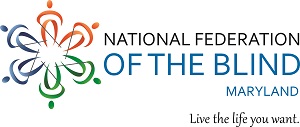To: Members of the Maryland General Assembly
From: Members of the National Federation of the Blind of Maryland
Contact: Sharon Maneki, President
National Federation of the Blind of Maryland
9013 Nelson Way
Columbia, MD 21045
Phone: 410-715-9596
Email: nfbmd@earthlink.net
Subject: Providing Blind and Visually Impaired Students with Orientation and Mobility Instruction
Date: January 22, 2015
________________________________________________________________________
THE PROBLEM
Historically, the long white cane has been used by blind and low vision individuals to navigate through their environments independently and efficiently. According to the Individuals with Disabilities Education Act, the federal law regulating special education, students who are blind or visually impaired should receive orientation and mobility (o&m) instruction. In Maryland, more low vision students who have some useable vision are being unjustly denied o&m instruction and are being declared ineligible for such training. As a result, many blind adults now find themselves unequipped with the skills to achieve their higher educational and employment goals because, as students, they were not properly assessed and given o&m training during their K-12 school years. These adults are frequently forced to interrupt their current educational and professional activities to obtain additional and costly training from state vocational rehabilitation programs to acquire these essential o&m skills.
PROPOSED ACTION
The Maryland General Assembly should enact legislation to provide blind and visually impaired students with instruction in Orientation and Mobility, unless after an evaluation of a child’s need for this instruction, the Individualized Education Program (IEP) team determines that such instruction is not appropriate. The evaluation shall consider, at a minimum, a child’s age, current and future needs, ability to function in familiar and unfamiliar areas, and under various lighting conditions.
BACKGROUND
Orientation and mobility (o&m) training is the practice of providing instruction to blind or low vision individuals on using specific nonvisual techniques and tools for navigating their environment safely and efficiently. Such skills when fully and properly implemented provide blind or low vision persons with an increased measure of independence. Independence is defined as the ability to go where you want, when you want, and without inconvenience to yourself or others.
Proper o&m training employs the use of the long white cane, experiential learning and problem solving so that students can navigate in both indoor and outdoor environments. O&m instruction includes learning about cardinal directions, street crossings, traffic patterns, and how to use public transportation. This instruction is most beneficial when taught in a completely nonvisual manner (i.e., students with some residual vision train under blindfold. Using a blindfold during instruction enables students to fully master the skills with confidence and without visual dependence.
Assessment of students’ need for o&m instruction is generally based on their functional vision rather than solely on their visual acuity. Items that should be considered during the assessment include: navigating stairs without holding handrails; transitioning in and out of various lighting conditions without disruption or adjustment; traveling unaided in unfamiliar environments and limited lighting conditions; locating specific landmarks in unfamiliar environments without assistance; etc.
MERITS OF THE PROPOSED LEGISLATION
-
Parental Rights to Information Will Be Enhanced
Many parents and guardians are unaware of the existence and benefits of o&m instruction. The members of the IEP Team never discuss this type of instruction because they falsely assume that students don’t need this instruction if they have some vision. The proposed legislation will require the local education agencies to provide oral and written notice to parents or guardians of blind or visually impaired children of the availability of o&m services. Understanding on the part of parents or guardians will be enhanced because the legislation stipulates that “a child may not be denied instruction in o&m solely because the child has some remaining vision.”
-
Educators Will Be Forced to Plan for O&M Instruction
The legislation instructs “the Maryland State Department of Education to issue guidelines to the local education agencies by September 2016 to fully implement the provisions of this act.” Guidelines are needed because local education agencies do not understand blindness and what blind students need. LEAs cannot immediately assess every student who may need o&m instruction. However, each LEA must begin to make plans to meet this responsibility. The days of no o&m instruction for students who desperately need it must come to an end.
-
Barriers to Full Participation in All Aspects of Community Life Will Be Reduced
Too many low vision students are afraid to go on field trips or participate in extracurricular activities, especially those that occur at night, because they cannot find their way in unfamiliar areas, and are too embarrassed to ask for help. These fears are frequently carried into adulthood, which further diminishes participation in all aspects of community life. Blind or low vision people will live full and meaningful lives if they have the chance to receive o&m instruction at an early age before such defeatist attitudes set in.
CONCLUSION
The goal of any primary and secondary educational system should be to equip its students with the knowledge and skills to succeed upon graduation from that system. For blind and low vision students, this must also include the ability to travel safely and independently by use of the long white cane.
The Maryland Literacy Rights and Education Act states that the IEP team must consider the child’s future needs, including whether the child has a medically indicated expectation of visual deterioration, when it relates to Braille instruction. These same factors must be considered when determining whether o&m instruction is appropriate for any child. The Maryland General Assembly must take action to ensure that blind and low vision students are properly assessed for o&m instruction. Parents must be made aware of the availability and benefits of this instruction through enactment of this legislation. Through proper training, blind and low vision students can compete on equal terms with their sighted peers. Failure to provide this instruction will condemn blind and low vision students to lives of diminished opportunities.
